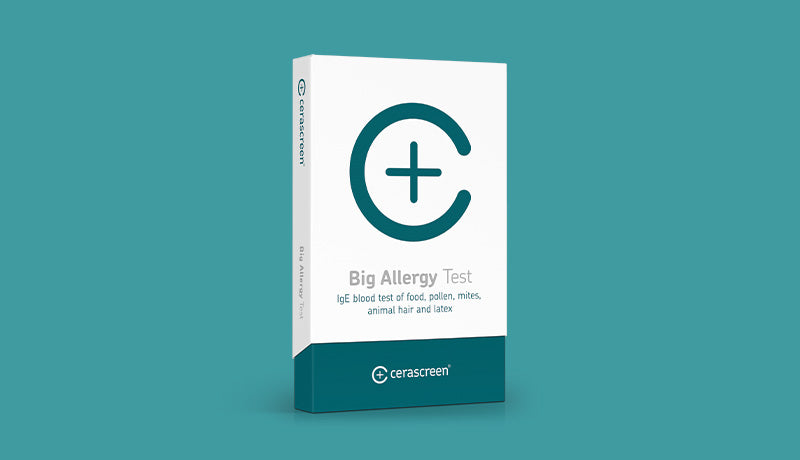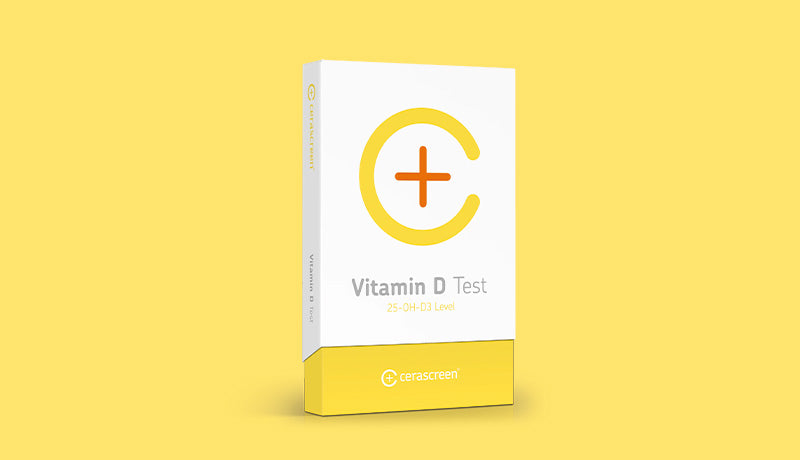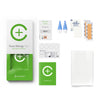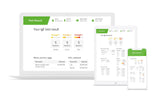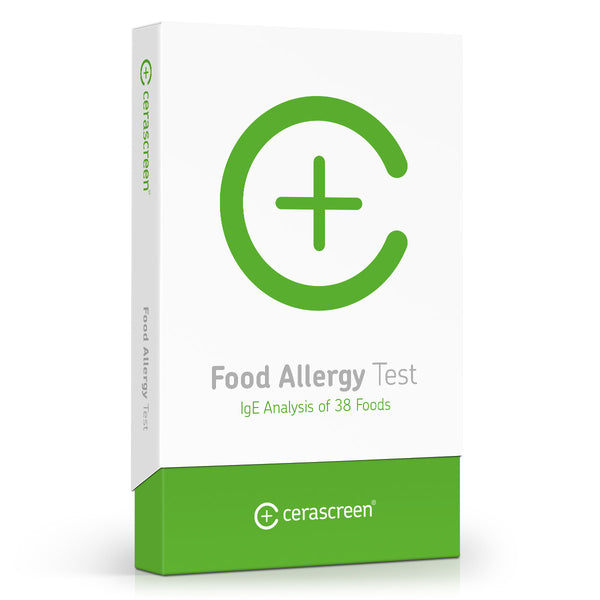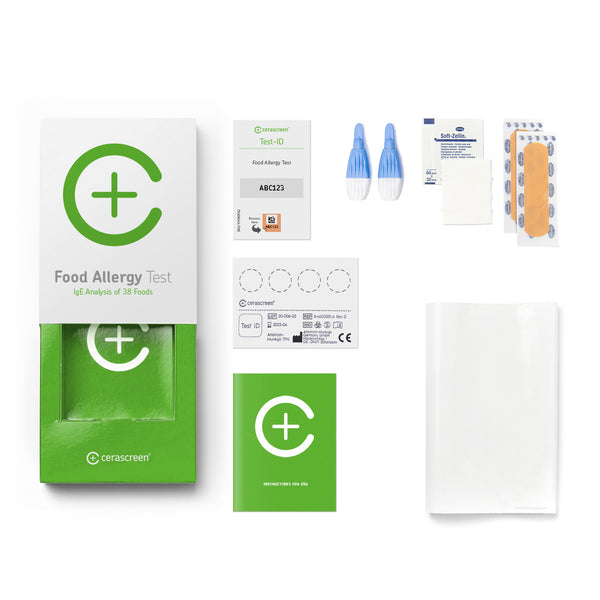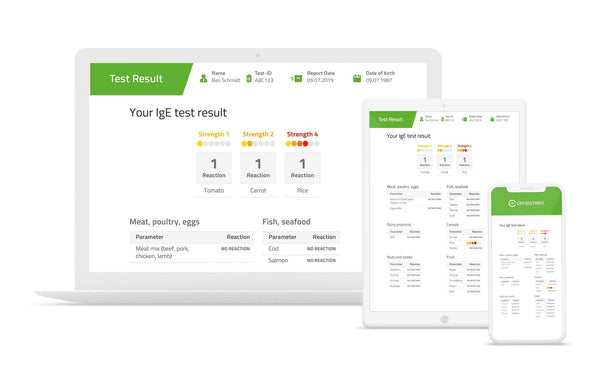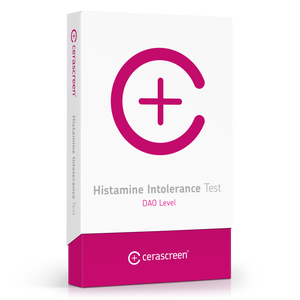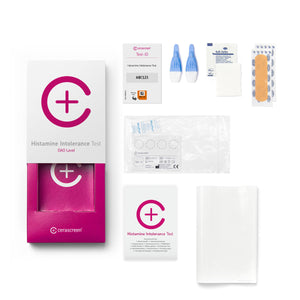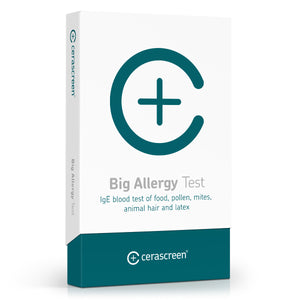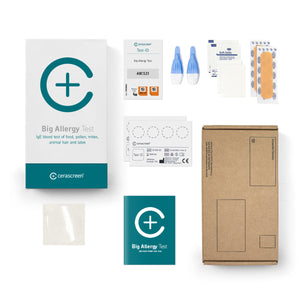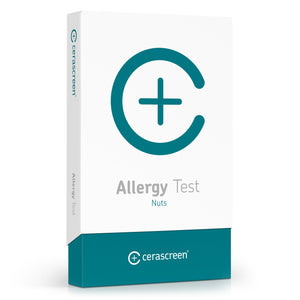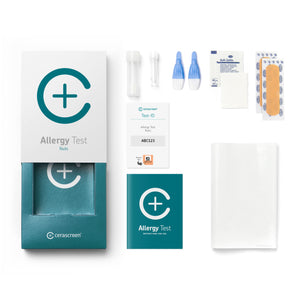product_id = 4980177469499variant_id = 33965724663867template_name =
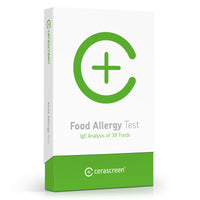
Food Allergy Test
About the test
Are you possibly allergic to food? This question is not always easy to answer. Severe allergy sufferers have often reacted to peanut, soy, fish, etc. with clear symptoms since childhood, but for some people, allergies develop over the course of their lives, and the signs are less clear. In everyday life, however, this can become uncomfortable and restrictive, with symptoms such as skin rashes, gastrointestinal problems or a sore throat.
The cerascreen® Food Allergy Test helps you investigate such hidden allergies. The send-in blood-sampling kit that you can use at home determines the concentration of specific IgE antibodies in your blood. This analysis provides first indications of a possible food allergy. For a definitive allergy diagnosis, discuss the results with your doctor.
Food Allergy Test
- Safe and easy to perform at home
- Certified laboratory analysis after a few days
- Medically established measurement of IgE antibodies
- Directly implementable recommendations and tips
- Receive your results within two to three business days after sample arrival
Benefits of the Food Allergy Test
Undetected food allergies can reduce your quality of life with various uncomfortable symptoms. These symptoms include rashes, a burning sensation in your mouth and on your tongue, diarrhoea and abdominal pain, an itchy throat and shortness of breath.
For the cerascreen® Food Allergy Test, you do not have to go to a doctor or clinic or wait for appointments. You will receive detailed, illustrated instructions and can easily take the sample comfortably at home. Our certified diagnostic laboratories then analyse your blood for IgE antibodies in response to 38 foods.
Take advantage of our expertise: cerascreen® is the market leader for at-home medical sample-taking and send-in kits in Europe, with eight years of experience in the development and analysis of tests. We have developed more than 50 different approved sample-taking and send-in kits (medical products) , analysed 250,000 samples and serve 19 different European countries.

Result of the Food Allergy Test
As soon as your sample has been analysed, you will receive a notification via the My cerascreen® app or your user account on our website for your test results. You can view your results on your smartphone, tablet or computer, and you can also print them out.
Discover, according to the lab analysis, if your blood shows a concentration of lgE antibodies in response to certain foods. Learn from our recommendations how you can continue to deal with allergies and still follow a balanced diet. The extensive health information provided explains what happens in the body in the case of an allergy and what you can do about it.
Frequently asked questions about Food Allergy Test
Why test for a food allergy?
Some people suffer from food allergies – often without knowing it. In some cases, the symptoms are annoying and unhealthy in the long run, but they are also subtle and difficult to attribute to specific meals. It can then make sense to get a first indication with a test to identify which foods you might not be able to tolerate.
In theory, you could be allergic to all kinds of foods. In practice, however, it is always the usual suspects that are responsible for a large part of allergies. These common food allergy triggers – and a few more – are taken into account in the cerascreen® Food Allergy Test.
If you can use the test to find out a previously undetected food allergy, it is important to remove that food item from your diet. This is more difficult with some foods than with others. Either way, you can avoid the cause of your complaints in the future.
How does the Food Allergy Test work?
For the Food Allergy Test, take a few drops of blood from your fingertip with one of the two lancets. Everything you need is included in the test kit.
The next step is to send the sample to a diagnostic laboratory. The laboratory analyses the amount of certain IgE antibodies in your blood. These antibodies indicate whether you are intolerant to one of 38 different foods. After the analysis, you will receive a notification and can access your personal results report via the online customer area or the My cerascreen® app.
Please note that the most meaningful results will only be obtained if you have had regular contact with the allergen in the two weeks or so prior to sampling. Some medications, for example antihistamines, can also influence the result.
What does the results report tell me?
The results report of the Food Allergy Test shows for which foods there are large amounts of IgE antibodies in the blood. A clear table shows you how strongly you are allergic to 38 different foods and food groups.
This intolerance shows the likelihood of your immune system having an allergic reaction to certain foods. This way, you receive a first indication of a possible food allergy.
The test cannot give you a definite allergy diagnosis. The diagnosis may only be made by doctors who combine allergy test results with your medical history – that is, question you about your symptoms and your state of health. However, you can use the results as a first point of reference to discuss a further course of action with your doctor, who may then no longer have to carry out skin tests or blood tests.
How long does the analysis take in the laboratory?
Once your sample has arrived at the laboratory, it will be analyzed there by specialists. How long the analysis takes depends on the exact measuring method and the processes in the laboratory.
If the sample is sent on the correct days (Sunday to Tuesday), this makes it easier for the laboratory to adhere to the times.
For the Food Allergy Test, the laboratory analysis is usually completed within 5 working days after the sample is received in the laboratory.
Which recommendations will I receive?
You will receive recommendations on how to deal with the test results. It is important that you take into account whether you have any symptoms after eating certain foods. Some people have an increased number of IgE antibodies against a certain food in their blood, but still show no symptoms. If this is the case for you, you will receive recommendations in the results report.
You will also receive recommendations on how to deal with identified allergies and how to make your diet healthy and balanced despite a potential food allergy. We give specific tips that you can use to support your digestive and intestinal health.
How common are food allergies?
According to estimates by AllergyUK, around 20 per cent of adults in the United Kingdom have a food allergy.
Allergies to food are somewhat more common in children, and in many cases, they go away on their own before adolescence or adulthood.
Which types of allergies will be tested?
There are different types of allergies. A type 1 allergy, also called immediate type allergy is by far the most common type. Food allergies generally fall into this category. These type 1 allergies are associated with increased concentrations of IgE antibodies. The cerascreen® Food Allergy Test examines precisely these concentrations in response to 38 different foods. This will give you first indications of a possible allergy of the immediate type.
What are IgE antibodies?
Antibodies are one of the defence mechanisms of your immune system. These are certain proteins. The body uses them primarily to fight off pathogens such as viruses and bacteria. There are different classes of antibodies, each with different tasks. The immunoglobulins E (IgE) specialise in defending against parasites – for example, worms.
When your body’s immune cells recognise pathogens or parasites, they pass this information on to plasma cells, a class of white blood cells. These then produce specific antibodies. ‘Specific’ in this context means that these antibodies are only there to initiate reactions against a specific pathogen.
How are IgE antibodies and allergies related?
If you have an allergy, your body has confused a harmless substance with a threatening pathogen in the past. Substances that can be used are proteins that are found in foods, pollen, animal hair, dust mites and medicines, among other things. These possible allergies triggers are called allergens.
The immune systems of allergy sufferers will have produced certain IgE antibodies to the allergen after confusing a harmless substance with a threatening pathogen. If the same substances enter the body again, your immune system will sound the alarm. They initiate defensive reactions: the messenger substance histamine is released, and inflammation occurs – the typical symptoms of an allergic reaction.
The IgE antibodies can stay in your body for your whole life. In some cases, the allergies disappear. In the case of food allergies, sensitisation usually begins in childhood. As child allergy sufferers become teenagers, many then lose their allergies to cow’s milk, eggs, wheat and soy. Allergies to nuts, fish and shellfish, in turn, persist in most cases for life.
What are the symptoms?
Food allergies are allergies of the immediate type. Symptoms usually appear immediately or only a few minutes after eating.
Typical symptoms of a food allergy are:
- Rashes and redness of the skin
- Gastrointestinal complaints such as diarrhoea, vomiting and abdominal pain
- An itchy palate and a ‘furry feeling’ on the tongue
- Breathing difficulties and allergic asthma
What is an anaphylactic shock?
In particular, nuts, soy and animal products – such as milk, egg and shellfish – can also cause a dangerous allergic reaction (anaphylactic shock). Blood pressure suddenly drops. This can lead to fainting and in rare cases even death.
If you have ever had an anaphylactic shock or you have been found to be at risk of having one, doctors will prescribe an anaphylaxis emergency kit. This includes medicines that you can use to counteract this violent allergic reaction, such as an an EpiPen (epinephrine pen) that allows you to inject adrenaline into the thigh, which usually prevents the drop in blood pressure.
How do you test for intolerances?
To take the food intolerance test, collect a small blood sample from your fingertip with one of the enclosed lancets. Only a few drops of blood are needed.
Return the sample using the free return envelope enclosed in the test kit. In the medical laboratory, the sample will be analysed to determine the level of certain IgE and IgG4 antibodies in the blood sample. When the analysis is complete, you will receive a notification and be able to access the results report easily when you log in to our website or even via the My cerascreen® app.
Important: You will get the most reliable results if you have followed a balanced diet for about two weeks before taking the sample. Also, please do not eat any foods that you know might cause a reaction (for example, anaphylactic shock). Please do not take any antihistamines either.
Why are children under 18 not allowed to take the test?
Our tests are not suitable for underage children and adolescents under the age of 18. Under 18s cannot activate the tests online and therefore cannot receive a test result. We ask that you do not administer the tests to your children either.
Children and adolescents need much closer supervision and counselling regarding medical tests and their interpretation. Testing with lancets and chemicals is not without risk and would need to be closely supervised by guardians. In addition, the reference values we give are always based on adult data. In the case of children, the risk of misinterpreting the results would be very high.
We want to fulfil our responsibility as a provider of medical products and ensure that children and adolescents are not unsettled by measurement results that are difficult for them to interpret. Since we cannot control whether the minors' legal guardians actually consent to the test being carried out and supervise them, we exclude tests for under 18s altogether.
If you are under 18 and have purchased a test, please contact our customer support.
Can I use the test to detect lactose intolerance or fructose intolerance?
The Food Intolerance Test & Food Allergy Test does not test for Lactose Intolerance Test and Fructose Intolerance Test. Histamine intolerance cannot be detected with this type of antibody blood test either. With the food reaction test, you get indications of reactions of the immune system to specific proteins (allergens), which in the case of IgE antibodies indicates, for example, allergies.
For other, special antibodies must be examined, for which other laboratory procedures are necessary. An analysis of the enzyme DAO in the blood provides an indication of histamine intolerance.
Lactose intolerance and fructose intolerance are not examined by blood test. A breath gas test is common here, in which it is analysed whether more gases such as hydrogen and methane are formed after ingestion of lactose or fructose and enter the air we breathe.
Here you will find other cerascreen tests that you can use to get tested for certain intolerances:
Why does the test have an expiration date?
The cerascreen® test kits are CE-marked medical devices, which in turn include other certified medical components such as lancets, patches, and alcohol swabs used in blood tests.
Like most medical devices, these components have an expiration date to ensure that they remain safe and effective. Many of our sample carriers – such as dried blood cards or sample tubes – are chemically treated to keep your sample stable and analyzable in our laboratory. Over time, environmental factors can affect this treatment and compromise accuracy.
Our sterile, single-use lancets also carry an expiration date to guarantee sterility and safe use up to that time.
This is how it works
1. Test at home
Your test kit contains everything you need to draw a small sample of blood from your fingertip. Then send the sample back to us free of charge in the enclosed return envelope.
2. View results online
After the evaluation in the medical specialist laboratory, you will have online access to your personal result report.
3. Act
Your access to the test results and the evidence-based findings and tips to improve your health: the my cerascreen® user profile on our website or our app.
